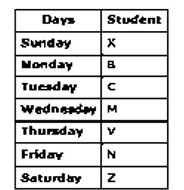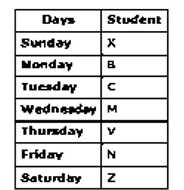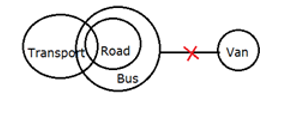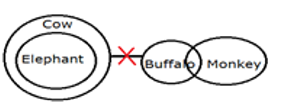Question 1:
Direction: Study the following information carefully and answer the below questions.
निर्देश : निम्नलिखित जानकारी सावधानी से पढ़ें और नीचे दिए गए प्रश्नों का उत्तर दें।
There are seven student viz. V, Z, C, N, M, X and B. Each has exam on different days of a week starting from Sunday to Saturday but not necessarily in the same order. Each scored different marks. Not more than one has exam on the same day and not more than one has scored same marks.
Z has exam either on first day or last day of the week. X doesn’t have exam in one of the days after Wednesday. Z scored more marks than V. Number of students having exam before M is as same as the number of students having exam after M. M either scored the highest mark or the lowest mark among them. Only two students scored between X and B, who has exam on Monday. The one who has exam on Wednesday scored least marks. X scored more marks than N, but less marks than Z. N has exam in one of the days after Thursday. V scored 4th highest mark and there is only person scored between X and V. The person who has exam on Tuesday scored more marks than the one who has exam on Friday. Three persons have exam between Z and C; C has exam in one of the days before Z.
सात छात्र V, Z, C, N, M, X और B हैं। प्रत्येक की परीक्षा रविवार से शनिवार वाले सप्ताह के विभिन्न दिनों में होती है लेकिन जरूरी नहीं कि उसी क्रम में। प्रत्येक ने अलग-अलग अंक प्राप्त किए। एक से अधिक का परीक्षा समान दिन में नहीं होता है और एक से अधिक, समान अंक प्राप्त नहीं करते हैं।
Z का परीक्षा या तो सप्ताह के पहले दिन या आखिरी दिन है। X का परीक्षा बुधवार के बाद किसी एक दिन नहीं है। Z ने V से अधिक अंक प्राप्त किए। M से पहले परीक्षा देने वाले छात्रों की संख्या, M के बाद परीक्षा देने वाले छात्रों की संख्या के समान है। M ने उनमें से या तो सबसे अधिक अंक या सबसे कम अंक प्राप्त किया है। X और B के बीच केवल दो छात्रों ने अंक प्राप्त किया, जिसका परीक्षा सोमवार को है। जिसका परीक्षा बुधवार को है, वह सबसे कम अंक प्राप्त करता है। X ने N से अधिक अंक प्राप्त किया, लेकिन Z से कम अंक प्राप्त किया। N का परीक्षा गुरुवार के बाद किसी एक दिन है। V ने चौथा सबसे अधिक अंक प्राप्त किया और X और V के बीच केवल एक व्यक्ति ने अंक पाप्त किया। जिस व्यक्ति का परीक्षा मंगलवार को है, उसने शुक्रवार को परीक्षा देने वाले से अधिक अंक प्राप्त किया। Z और C के बीच तीन लोगों की परीक्षा है; C का परीक्षा Z से किसी एक दिन पहले है।
How many students have exam between X and B?
X और B के बीच कितने छात्रों की परीक्षा है?
Question 2:
Direction: Study the following information carefully and answer the below questions.
निर्देश : निम्नलिखित जानकारी सावधानी से पढ़ें और नीचे दिए गए प्रश्नों का उत्तर दें।
There are seven student viz. V, Z, C, N, M, X and B. Each has exam on different days of a week starting from Sunday to Saturday but not necessarily in the same order. Each scored different marks. Not more than one has exam on the same day and not more than one has scored same marks.
Z has exam either on first day or last day of the week. X doesn’t have exam in one of the days after Wednesday. Z scored more marks than V. Number of students having exam before M is as same as the number of students having exam after M. M either scored the highest mark or the lowest mark among them. Only two students scored between X and B, who has exam on Monday. The one who has exam on Wednesday scored least marks. X scored more marks than N, but less marks than Z. N has exam in one of the days after Thursday. V scored 4th highest mark and there is only person scored between X and V. The person who has exam on Tuesday scored more marks than the one who has exam on Friday. Three persons have exam between Z and C; C has exam in one of the days before Z.
सात छात्र V, Z, C, N, M, X और B हैं। प्रत्येक की परीक्षा रविवार से शनिवार वाले सप्ताह के विभिन्न दिनों में होती है लेकिन जरूरी नहीं कि उसी क्रम में। प्रत्येक ने अलग-अलग अंक प्राप्त किए। एक से अधिक का परीक्षा समान दिन में नहीं होता है और एक से अधिक, समान अंक प्राप्त नहीं करते हैं।
Z का परीक्षा या तो सप्ताह के पहले दिन या आखिरी दिन है। X का परीक्षा बुधवार के बाद किसी एक दिन नहीं है। Z ने V से अधिक अंक प्राप्त किए। M से पहले परीक्षा देने वाले छात्रों की संख्या, M के बाद परीक्षा देने वाले छात्रों की संख्या के समान है। M ने उनमें से या तो सबसे अधिक अंक या सबसे कम अंक प्राप्त किया है। X और B के बीच केवल दो छात्रों ने अंक प्राप्त किया, जिसका परीक्षा सोमवार को है। जिसका परीक्षा बुधवार को है, वह सबसे कम अंक प्राप्त करता है। X ने N से अधिक अंक प्राप्त किया, लेकिन Z से कम अंक प्राप्त किया। N का परीक्षा गुरुवार के बाद किसी एक दिन है। V ने चौथा सबसे अधिक अंक प्राप्त किया और X और V के बीच केवल एक व्यक्ति ने अंक पाप्त किया। जिस व्यक्ति का परीक्षा मंगलवार को है, उसने शुक्रवार को परीक्षा देने वाले से अधिक अंक प्राप्त किया। Z और C के बीच तीन लोगों की परीक्षा है; C का परीक्षा Z से किसी एक दिन पहले है।
Who among the following has exam on Thursday?
निम्नलिखित में से किसका परीक्षा गुरुवार को है?
Question 3:
Direction: Study the following information carefully and answer the below questions.
निर्देश : निम्नलिखित जानकारी सावधानी से पढ़ें और नीचे दिए गए प्रश्नों का उत्तर दें।
There are seven student viz. V, Z, C, N, M, X and B. Each has exam on different days of a week starting from Sunday to Saturday but not necessarily in the same order. Each scored different marks. Not more than one has exam on the same day and not more than one has scored same marks.
Z has exam either on first day or last day of the week. X doesn’t have exam in one of the days after Wednesday. Z scored more marks than V. Number of students having exam before M is as same as the number of students having exam after M. M either scored the highest mark or the lowest mark among them. Only two students scored between X and B, who has exam on Monday. The one who has exam on Wednesday scored least marks. X scored more marks than N, but less marks than Z. N has exam in one of the days after Thursday. V scored 4th highest mark and there is only person scored between X and V. The person who has exam on Tuesday scored more marks than the one who has exam on Friday. Three persons have exam between Z and C; C has exam in one of the days before Z.
सात छात्र V, Z, C, N, M, X और B हैं। प्रत्येक की परीक्षा रविवार से शनिवार वाले सप्ताह के विभिन्न दिनों में होती है लेकिन जरूरी नहीं कि उसी क्रम में। प्रत्येक ने अलग-अलग अंक प्राप्त किए। एक से अधिक का परीक्षा समान दिन में नहीं होता है और एक से अधिक, समान अंक प्राप्त नहीं करते हैं।
Z का परीक्षा या तो सप्ताह के पहले दिन या आखिरी दिन है। X का परीक्षा बुधवार के बाद किसी एक दिन नहीं है। Z ने V से अधिक अंक प्राप्त किए। M से पहले परीक्षा देने वाले छात्रों की संख्या, M के बाद परीक्षा देने वाले छात्रों की संख्या के समान है। M ने उनमें से या तो सबसे अधिक अंक या सबसे कम अंक प्राप्त किया है। X और B के बीच केवल दो छात्रों ने अंक प्राप्त किया, जिसका परीक्षा सोमवार को है। जिसका परीक्षा बुधवार को है, वह सबसे कम अंक प्राप्त करता है। X ने N से अधिक अंक प्राप्त किया, लेकिन Z से कम अंक प्राप्त किया। N का परीक्षा गुरुवार के बाद किसी एक दिन है। V ने चौथा सबसे अधिक अंक प्राप्त किया और X और V के बीच केवल एक व्यक्ति ने अंक पाप्त किया। जिस व्यक्ति का परीक्षा मंगलवार को है, उसने शुक्रवार को परीक्षा देने वाले से अधिक अंक प्राप्त किया। Z और C के बीच तीन लोगों की परीक्षा है; C का परीक्षा Z से किसी एक दिन पहले है।
Which of the following combination is true?
निम्नलिखित में से कौन सा संयोजन सत्य है?
Question 4:
Direction: Study the following information carefully and answer the below questions.
निर्देश : निम्नलिखित जानकारी सावधानी से पढ़ें और नीचे दिए गए प्रश्नों का उत्तर दें।
There are seven student viz. V, Z, C, N, M, X and B. Each has exam on different days of a week starting from Sunday to Saturday but not necessarily in the same order. Each scored different marks. Not more than one has exam on the same day and not more than one has scored same marks.
Z has exam either on first day or last day of the week. X doesn’t have exam in one of the days after Wednesday. Z scored more marks than V. Number of students having exam before M is as same as the number of students having exam after M. M either scored the highest mark or the lowest mark among them. Only two students scored between X and B, who has exam on Monday. The one who has exam on Wednesday scored least marks. X scored more marks than N, but less marks than Z. N has exam in one of the days after Thursday. V scored 4th highest mark and there is only person scored between X and V. The person who has exam on Tuesday scored more marks than the one who has exam on Friday. Three persons have exam between Z and C; C has exam in one of the days before Z.
सात छात्र V, Z, C, N, M, X और B हैं। प्रत्येक की परीक्षा रविवार से शनिवार वाले सप्ताह के विभिन्न दिनों में होती है लेकिन जरूरी नहीं कि उसी क्रम में। प्रत्येक ने अलग-अलग अंक प्राप्त किए। एक से अधिक का परीक्षा समान दिन में नहीं होता है और एक से अधिक, समान अंक प्राप्त नहीं करते हैं।
Z का परीक्षा या तो सप्ताह के पहले दिन या आखिरी दिन है। X का परीक्षा बुधवार के बाद किसी एक दिन नहीं है। Z ने V से अधिक अंक प्राप्त किए। M से पहले परीक्षा देने वाले छात्रों की संख्या, M के बाद परीक्षा देने वाले छात्रों की संख्या के समान है। M ने उनमें से या तो सबसे अधिक अंक या सबसे कम अंक प्राप्त किया है। X और B के बीच केवल दो छात्रों ने अंक प्राप्त किया, जिसका परीक्षा सोमवार को है। जिसका परीक्षा बुधवार को है, वह सबसे कम अंक प्राप्त करता है। X ने N से अधिक अंक प्राप्त किया, लेकिन Z से कम अंक प्राप्त किया। N का परीक्षा गुरुवार के बाद किसी एक दिन है। V ने चौथा सबसे अधिक अंक प्राप्त किया और X और V के बीच केवल एक व्यक्ति ने अंक पाप्त किया। जिस व्यक्ति का परीक्षा मंगलवार को है, उसने शुक्रवार को परीक्षा देने वाले से अधिक अंक प्राप्त किया। Z और C के बीच तीन लोगों की परीक्षा है; C का परीक्षा Z से किसी एक दिन पहले है।
If B and V interchanged their exam schedule, then how many students have exam after B?
यदि B और V ने अपने परीक्षा कार्यक्रम परस्पर बदल दिया है, तो B के बाद कितने छात्रों की परीक्षा है?
Question 5:
Direction: Study the following information carefully and answer the below questions.
निर्देश : निम्नलिखित जानकारी सावधानी से पढ़ें और नीचे दिए गए प्रश्नों का उत्तर दें।
There are seven student viz. V, Z, C, N, M, X and B. Each has exam on different days of a week starting from Sunday to Saturday but not necessarily in the same order. Each scored different marks. Not more than one has exam on the same day and not more than one has scored same marks.
Z has exam either on first day or last day of the week. X doesn’t have exam in one of the days after Wednesday. Z scored more marks than V. Number of students having exam before M is as same as the number of students having exam after M. M either scored the highest mark or the lowest mark among them. Only two students scored between X and B, who has exam on Monday. The one who has exam on Wednesday scored least marks. X scored more marks than N, but less marks than Z. N has exam in one of the days after Thursday. V scored 4th highest mark and there is only person scored between X and V. The person who has exam on Tuesday scored more marks than the one who has exam on Friday. Three persons have exam between Z and C; C has exam in one of the days before Z.
सात छात्र V, Z, C, N, M, X और B हैं। प्रत्येक की परीक्षा रविवार से शनिवार वाले सप्ताह के विभिन्न दिनों में होती है लेकिन जरूरी नहीं कि उसी क्रम में। प्रत्येक ने अलग-अलग अंक प्राप्त किए। एक से अधिक का परीक्षा समान दिन में नहीं होता है और एक से अधिक, समान अंक प्राप्त नहीं करते हैं।
Z का परीक्षा या तो सप्ताह के पहले दिन या आखिरी दिन है। X का परीक्षा बुधवार के बाद किसी एक दिन नहीं है। Z ने V से अधिक अंक प्राप्त किए। M से पहले परीक्षा देने वाले छात्रों की संख्या, M के बाद परीक्षा देने वाले छात्रों की संख्या के समान है। M ने उनमें से या तो सबसे अधिक अंक या सबसे कम अंक प्राप्त किया है। X और B के बीच केवल दो छात्रों ने अंक प्राप्त किया, जिसका परीक्षा सोमवार को है। जिसका परीक्षा बुधवार को है, वह सबसे कम अंक प्राप्त करता है। X ने N से अधिक अंक प्राप्त किया, लेकिन Z से कम अंक प्राप्त किया। N का परीक्षा गुरुवार के बाद किसी एक दिन है। V ने चौथा सबसे अधिक अंक प्राप्त किया और X और V के बीच केवल एक व्यक्ति ने अंक पाप्त किया। जिस व्यक्ति का परीक्षा मंगलवार को है, उसने शुक्रवार को परीक्षा देने वाले से अधिक अंक प्राप्त किया। Z और C के बीच तीन लोगों की परीक्षा है; C का परीक्षा Z से किसी एक दिन पहले है।
Who among the following scored the fifth least marks?
निम्नलिखित में से किसने पाँचवाँ सबसे कम अंक बनाया?
Question 6:
Direction : In each of the following questions some statements are followed by four conclusions numbered I and II. You have to take the given statements to be true even if they seem to be at variance from commonly known facts. Read the conclusions and then decide which of the given conclusions logically follows from the given statements.
निर्देश : निम्नलिखित प्रत्येक प्रश्न में कुछ कथनों के बाद दो निष्कर्ष I और II दिए गए हैं। आपको दिए गए कथनों को सत्य मानना है, भले ही वे आम तौर पर ज्ञात तथ्यों से भिन्न प्रतित होते हों। निष्कर्ष पढ़ें और फिर तय करें कि दिए गए निष्कर्षों में से कौन से निष्कर्ष तर्कसंगत रूप से दिए गए कथन का अनुसरण करते हैं।
(a) Either conclusion I or conclusion II follows
(a) या तो निष्कर्ष I या निष्कर्ष II अनुसरण करता है
(b) Only conclusion I follow
(b) केवल निष्कर्ष I अनुसरण करता है
(c) Both conclusion I and conclusion II follows
(c) दोनों निष्कर्ष I और निष्कर्ष II अनुसरण करता है
(d) Only conclusion II follows
(d) केवल निष्कर्ष II अनुसरण करता है
(e) Neither conclusion I nor conclusion II follows
(e) न तो निष्कर्ष I न निष्कर्ष II अनुसरण करता है
Statements: Some Books are Pens.
कथन: कुछ बुक पेन हैं,
Some Pencil are Eraser.
कुछ पेंसिल इरेज़र हैं
No Pen is Pencil.
कोई पेन पेंसिल नहीं है
Conclusions: I. No Pen is Eraser is a possibility
निष्कर्ष: I. कोई पेन के इरेजर नहीं होने की संभावना है
II. Some Books are not Pencils
II. कुछ बुक पेंसिल नहीं है
Question 7:
Direction : In each of the following questions some statements are followed by four conclusions numbered I and II. You have to take the given statements to be true even if they seem to be at variance from commonly known facts. Read the conclusions and then decide which of the given conclusions logically follows from the given statements.
निर्देश : निम्नलिखित प्रत्येक प्रश्न में कुछ कथनों के बाद दो निष्कर्ष I और II दिए गए हैं। आपको दिए गए कथनों को सत्य मानना है, भले ही वे आम तौर पर ज्ञात तथ्यों से भिन्न प्रतित होते हों। निष्कर्ष पढ़ें और फिर तय करें कि दिए गए निष्कर्षों में से कौन से निष्कर्ष तर्कसंगत रूप से दिए गए कथन का अनुसरण करते हैं।
(a) Either conclusion I or conclusion II follows
(a) या तो निष्कर्ष I या निष्कर्ष II अनुसरण करता है
(b) Only conclusion I follow
(b) केवल निष्कर्ष I अनुसरण करता है
(c) Both conclusion I and conclusion II follows
(c) दोनों निष्कर्ष I और निष्कर्ष II अनुसरण करता है
(d) Only conclusion II follows
(d) केवल निष्कर्ष II अनुसरण करता है
(e) Neither conclusion I nor conclusion II follows
(e) न तो निष्कर्ष I न निष्कर्ष II अनुसरण करता है
Statements: Some Cable are Memory.
कथन: कुछ केबल मेमोरी हैं,
Some CPU are Mouse. / कुछ सीपीयू माउस हैं
All Monitor are CPU. / सभी मॉनीटर सीपीयू हैं,
All Mouse are Cable. / सभी माउस केबल हैं
Conclusions: I. Some CPU are Memory is a possibility
निष्कर्ष: I. कुछ सीपीयू के मेमोरी होने की संभावना है
II. Some Cable are Monitor
II. कुछ केबल मॉनीटर है
Question 8:
Direction : In each of the following questions some statements are followed by four conclusions numbered I and II. You have to take the given statements to be true even if they seem to be at variance from commonly known facts. Read the conclusions and then decide which of the given conclusions logically follows from the given statements.
निर्देश : निम्नलिखित प्रत्येक प्रश्न में कुछ कथनों के बाद दो निष्कर्ष I और II दिए गए हैं। आपको दिए गए कथनों को सत्य मानना है, भले ही वे आम तौर पर ज्ञात तथ्यों से भिन्न प्रतित होते हों। निष्कर्ष पढ़ें और फिर तय करें कि दिए गए निष्कर्षों में से कौन से निष्कर्ष तर्कसंगत रूप से दिए गए कथन का अनुसरण करते हैं।
(a) Either conclusion I or conclusion II follows
(a) या तो निष्कर्ष I या निष्कर्ष II अनुसरण करता है
(b) Only conclusion I follow
(b) केवल निष्कर्ष I अनुसरण करता है
(c) Both conclusion I and conclusion II follows
(c) दोनों निष्कर्ष I और निष्कर्ष II अनुसरण करता है
(d) Only conclusion II follows
(d) केवल निष्कर्ष II अनुसरण करता है
(e) Neither conclusion I nor conclusion II follows
(e) न तो निष्कर्ष I न निष्कर्ष II अनुसरण करता है
Statements: No Room is an Apartment.
कथन: कोई कमरा अपार्टमेंट नहीं है,
Some Buildings are Floor. कुछ इमारत मंजिल हैं
All Apartments are Buildings. सभी अपार्टमेंट इमारत हैं
Conclusions: I. Some Building are not Room
निष्कर्ष: I. कुछ इमारत कमरा नहीं है
II. Some Floor are Apartment
II. कुछ मंजिल अपार्टमेंट है
Question 9:
Direction : In each of the following questions some statements are followed by four conclusions numbered I and II. You have to take the given statements to be true even if they seem to be at variance from commonly known facts. Read the conclusions and then decide which of the given conclusions logically follows from the given statements.
निर्देश : निम्नलिखित प्रत्येक प्रश्न में कुछ कथनों के बाद दो निष्कर्ष I और II दिए गए हैं। आपको दिए गए कथनों को सत्य मानना है, भले ही वे आम तौर पर ज्ञात तथ्यों से भिन्न प्रतित होते हों। निष्कर्ष पढ़ें और फिर तय करें कि दिए गए निष्कर्षों में से कौन से निष्कर्ष तर्कसंगत रूप से दिए गए कथन का अनुसरण करते हैं।
(a) Either conclusion I or conclusion II follows
(a) या तो निष्कर्ष I या निष्कर्ष II अनुसरण करता है
(b) Only conclusion I follow
(b) केवल निष्कर्ष I अनुसरण करता है
(c) Both conclusion I and conclusion II follows
(c) दोनों निष्कर्ष I और निष्कर्ष II अनुसरण करता है
(d) Only conclusion II follows
(d) केवल निष्कर्ष II अनुसरण करता है
(e) Neither conclusion I nor conclusion II follows
(e) न तो निष्कर्ष I न निष्कर्ष II अनुसरण करता है
Statements: Some Transports are Roads.
कथन: कुछ परिवहन सड़क हैं,
All Roads are Buses. सभी सड़क बस हैं
No Bus is Van. कोई बस वैन नहीं है
Conclusions: I. Some Transports are Van कुछ ट्रांसपोर्ट वैन हैं
II. All Van being Transports is a possibility सभी वैन के ट्रांसपोर्ट होने की संभावना है
Question 10:
Direction : In each of the following questions some statements are followed by four conclusions numbered I and II. You have to take the given statements to be true even if they seem to be at variance from commonly known facts. Read the conclusions and then decide which of the given conclusions logically follows from the given statements.
निर्देश : निम्नलिखित प्रत्येक प्रश्न में कुछ कथनों के बाद दो निष्कर्ष I और II दिए गए हैं। आपको दिए गए कथनों को सत्य मानना है, भले ही वे आम तौर पर ज्ञात तथ्यों से भिन्न प्रतित होते हों। निष्कर्ष पढ़ें और फिर तय करें कि दिए गए निष्कर्षों में से कौन से निष्कर्ष तर्कसंगत रूप से दिए गए कथन का अनुसरण करते हैं।
(a) Either conclusion I or conclusion II follows
(a) या तो निष्कर्ष I या निष्कर्ष II अनुसरण करता है
(b) Only conclusion I follow
(b) केवल निष्कर्ष I अनुसरण करता है
(c) Both conclusion I and conclusion II follows
(c) दोनों निष्कर्ष I और निष्कर्ष II अनुसरण करता है
(d) Only conclusion II follows
(d) केवल निष्कर्ष II अनुसरण करता है
(e) Neither conclusion I nor conclusion II follows
(e) न तो निष्कर्ष I न निष्कर्ष II अनुसरण करता है
Statements: Some Buffaloes are Monkey.
कथन: कुछ भैंस बंदर हैं,
All Elephants are Cows. सभी हाथी गाय हैं
No Cow is Buffalo. कोई गाय भैंस नहीं है
Conclusions: I. No Buffalo is Elephant
निष्कर्ष: I. कोई भैंस हाथी नहीं है
II. Some Monkeys are not cow
II. कुछ बंदर गाय नहीं है










